TL;DR
- Prompt-to-app builders turn plain-English ideas into deployable web apps in 2025
- Use 5 criteria: code ownership, structured output, security, safe changes, integrations
- The list compares 12 tools, from Base44 and Bolt.new to Retool and Zoho Creator
- Flatlogic Generator offers full code export, deterministic code, and governance
- AI prompts now create 38% of new web apps vs 20.8% manual coding
Fact Box
- Flatlogic study: In 2025, 38% of new web apps are generated via AI prompts, vs 20.8% via manual coding.
- Five selection criteria: code ownership, deterministic output, security, agentic changes, and integrations.
- Flatlogic Generator offers full code ownership, structured deterministic output, and version control with rollback.
- Retool targets enterprises with strong data integrations, deterministic outputs, governance, and auditability.
- OpenAI Apps face limited EU availability and unclear monetization, per the article's assessment.
You can now go from “idea” to a running web app with a single prompt, but which prompt-to-app builders are actually worth your time in 2025?
Ever imagined creating a fully functional web application by simply describing your idea in plain English? In 2025, this vision has become a reality. The emergence of prompt-to-app builders has revolutionized the way we approach software development, enabling rapid prototyping and deployment without the need for extensive coding knowledge.
When searching for the best tools to turn your ideas into applications, you might ask:
- Which platforms allow me to build apps using natural language prompts?
- How do these tools compare in terms of scalability and customization?
- Are there options suitable for both non-technical users and experienced developers?
As Steve Jobs once said, “Innovation distinguishes between a leader and a follower.” In the realm of app development, embracing innovative tools can set you apart in a competitive market.
The traditional approach to app development often involves lengthy coding processes, requiring specialized knowledge and significant time investment. However, the rise of AI-powered prompt-to-app builders has addressed this challenge, offering intuitive platforms that streamline the development process. According to a recent study by Flatlogic, 2025 has seen a significant shift towards AI-driven development, with over 38% of new web applications being generated through AI prompts, compared to just 20.8% through manual coding.
By reading this article, you’ll be equipped with knowledge about the top prompt-to-app builders of 2025, including their features, ideal use cases, and how they can accelerate your app development journey.
What are Prompt-to-App Builders?
Prompt-to-App Builders are a rapidly growing class of software platforms that enable users to create fully-functional applications from simple natural-language descriptions (prompts). Instead of coding manually, users explain their app ideas in plain English, and these AI-driven systems automatically translate the descriptions into structured schemas, components, and even complete codebases ready for deployment. 
The fundamental innovation here is the shift from manual development or traditional no-code visual builders towards a conversational approach. You tell the tool what you need, and it generates the application for you. This dramatically accelerates the development cycle, lowers the entry barrier for non-technical users, and allows technical teams to prototype and validate ideas without manual coding rapidly.
In practice, prompt-to-app builders differ significantly from traditional low-code/no-code solutions. Instead of dragging components or writing explicit logic, you provide prompts such as:
- “Create a CRM dashboard to manage clients, track leads, and generate sales reports monthly.”
- “Build an inventory management app connected to my Shopify store.”
The platform parses your intent, generates a structured representation (often as a JSON schema), and then deterministically generates high-quality, maintainable code that you can deploy, customize, and scale without vendor lock-in.
How to Choose the Right Prompt-to-App Builder (5 Key Criteria)
With numerous prompt-to-app builders emerging, selecting the right tool can feel overwhelming. Use these five pragmatic criteria to quickly narrow your choice and ensure your investment aligns with both your short-term goals and long-term vision:
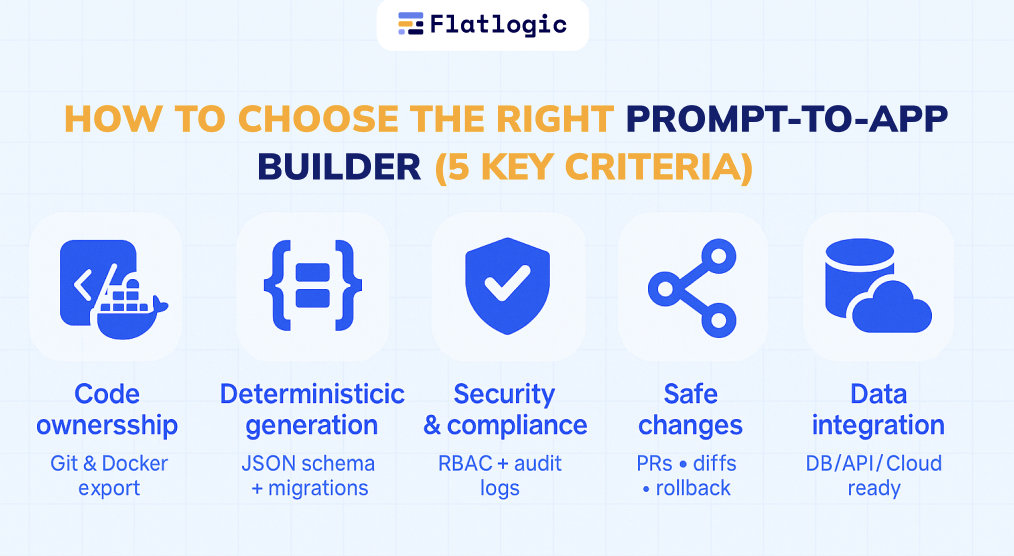
1. Code Ownership & Exportability
Always verify that the platform allows full code ownership. The ability to export your generated code, deploy it anywhere, and independently modify it is critical to avoid vendor lock-in and future-proof your technology decisions.
- Good: Platforms that give full code export via Git and Docker.
- Red Flag: Platforms only offering hosted deployments without clear export paths.
2. Structured, Deterministic Generation
Look for platforms that translate prompts into structured schemas or components before generating the code. This approach provides more predictable, testable, and maintainable outputs than purely AI-driven “raw” code generation.
- Good: Builders producing structured JSON schemas, database migrations, and standardized UI components.
- Red Flag: Purely generative outputs requiring constant debugging, refactoring, or manual corrections.
3. Security & Compliance
Evaluate platforms based on their security practices, audit trails, role-based access control (RBAC), and compliance with regulatory standards like GDPR or SOC 2.
- Good: Platforms providing robust security documentation, audit logs, granular permissions, and clear data residency options.
- Red Flag: Platforms with no clearly documented security policies or recent security incidents.
4. Incremental, Safe Changes (Agentic Capabilities)
Prefer platforms capable of safely making incremental updates, opening pull requests, allowing diffs, enabling rollbacks, and providing approvals, especially crucial for the continuous improvement of your app in production.
- Good: Platforms with built-in version control, approval workflows, and rollback support.
- Red Flag: Platforms that overwrite previous versions blindly, offering no safe rollback or versioning strategy.
5. Data Integration & Ecosystem Fit
Ensure the platform seamlessly integrates with your existing databases, APIs, and third-party tools. Consider your current stack (e.g., MariaDB/MySQL/Postgres, Google Cloud Run, AWS), and verify the platform natively supports these ecosystems.
- Good: First-class support for major databases, APIs, and popular cloud providers.
- Red Flag: Limited data connectivity or proprietary connectors forcing major workarounds.
Quick Checklist (Use This as Your Buyer’s Guide):
| Must-have Criteria | Questions to Ask |
| Code Ownership | Can I export all generated code and deploy freely? |
| Structured Output | Is the generated code structured and maintainable? |
| Security & Auditability | Does the platform document security & compliance? |
| Agentic Capabilities | Can I safely update and roll back incremental changes? |
| Data & Ecosystem Integration | Does it natively support my databases and APIs? |
The right prompt-to-app builder balances conversational ease with robust engineering practices. Platforms like Flatlogic Generator check all these boxes, combining structured code generation, complete code ownership, secure governance, and seamless data integration, empowering teams to rapidly deliver secure, maintainable, and scalable apps.
Top 12 Prompt-to-App Builders (2025)
In a rapidly evolving landscape of AI-driven development, choosing the right prompt-to-app builder can significantly accelerate your app creation process and help you maintain a competitive edge. We’ve carefully analyzed the leading platforms available in 2025, evaluating their strengths, ideal use cases, and potential drawbacks. Here’s a clear, concise overview of the top 12 prompt-to-app builders worth your attention this year.
1. Base44
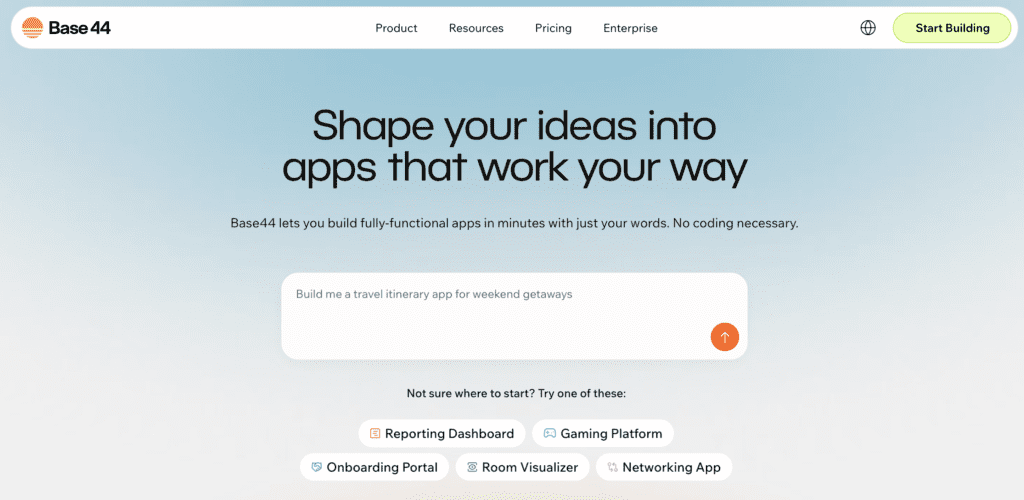
Base44 simplifies app creation by turning conversational prompts into straightforward business applications. Ideal for teams without dedicated developers, it rapidly scaffolds internal apps, forms, and dashboards. Base44 emphasizes ease of use and quick setup, making it appealing for non-technical users.
- Key Advantages: Fast conversational setup; simple business apps; intuitive UI.
- Target Audience: Non-technical SMB teams, marketers, and operational roles.
- Complexity: Low complexity, simple CRUD-based internal apps.
- Pitfalls: Limited customization; recent security concerns require thorough review.
2. Bolt.new
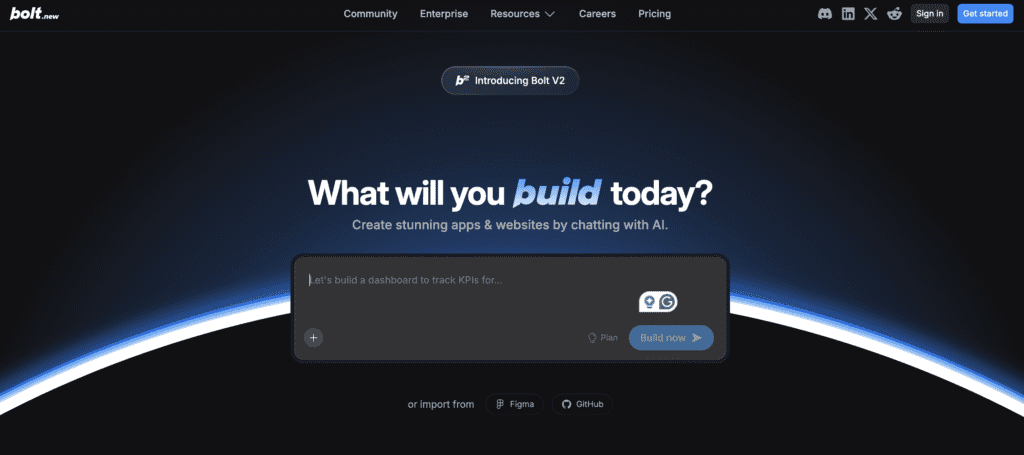
Bolt.new transforms plain-text prompts into web apps and prototypes swiftly, providing developers quick routes from idea to MVP. It specializes in spinning up apps using popular web stacks and easily integrates with external services. Ideal for developers who value speed and simple deployment.
- Key Advantages: Fast prototyping; seamless integrations; strong UX.
- Target Audience: Developers, technical product teams, and founders prototyping ideas.
- Complexity: Medium complexity, web apps, CRUD-based applications, basic SaaS MVPs.
- Pitfalls: Limited enterprise-level controls; requires manual checks for security and scalability.
3. Create.xyz
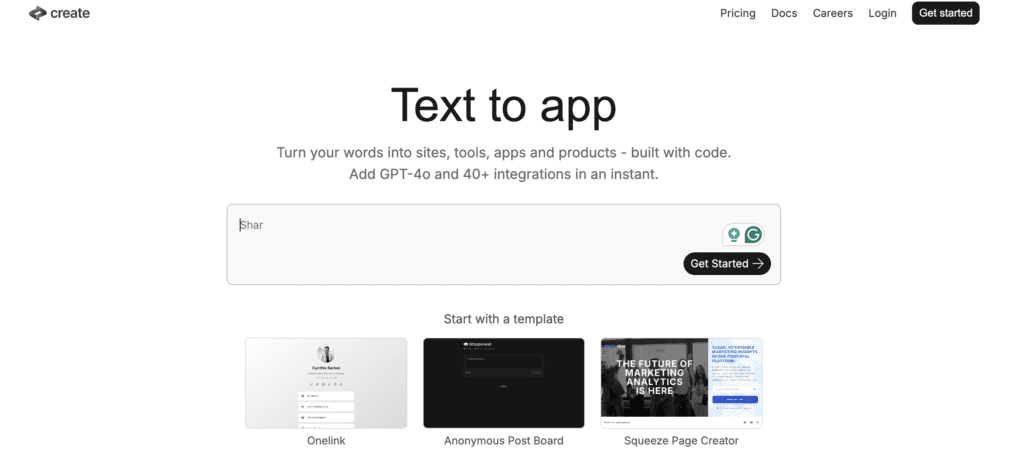
Create.xyz is an AI-powered “IDE-in-browser” tool designed for technical users who enjoy coding in a conversational, natural-language environment. Users describe their applications, workflows, or scripts, and Create.xyz compiles a functional app or utility. It integrates multiple models and APIs to give a rich development experience.
- Key Advantages: Multi-model integrations; conversational coding environment; rapid prototyping.
- Target Audience: Developers, technical hobbyists, and innovation labs.
- Complexity: Medium, well-suited for tools, scripts, prototypes, MVPs.
- Pitfalls: Less suitable for enterprise-grade production; lacks robust governance and audit trails.
4. Flatlogic Generator
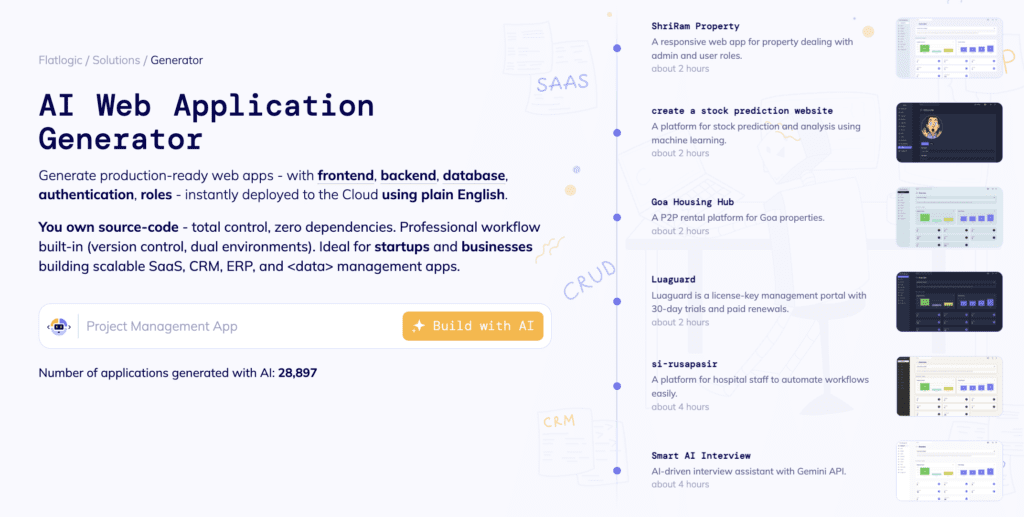
Flatlogic Generator uniquely combines natural-language prompts with deterministic code generation, translating structured schemas into robust, exportable web apps. Users own and control the complete codebase, enabling true customization and scalability. Ideal for building scalable SaaS, ERP, CRM, and analytics dashboards rapidly.
- Key Advantages: Full code ownership; structured deterministic output; built-in version control and rollback.
- Target Audience: Technical founders, product teams, and enterprise buyers who prioritize maintainability and governance.
- Complexity: High complexity, production-grade SaaS apps, CRM/ERP, BI dashboards.
- Pitfalls: Requires technical skills for advanced customization; limited to defined stacks (e.g., Next.js, Node.js).
5. Glide (AI App Generator)
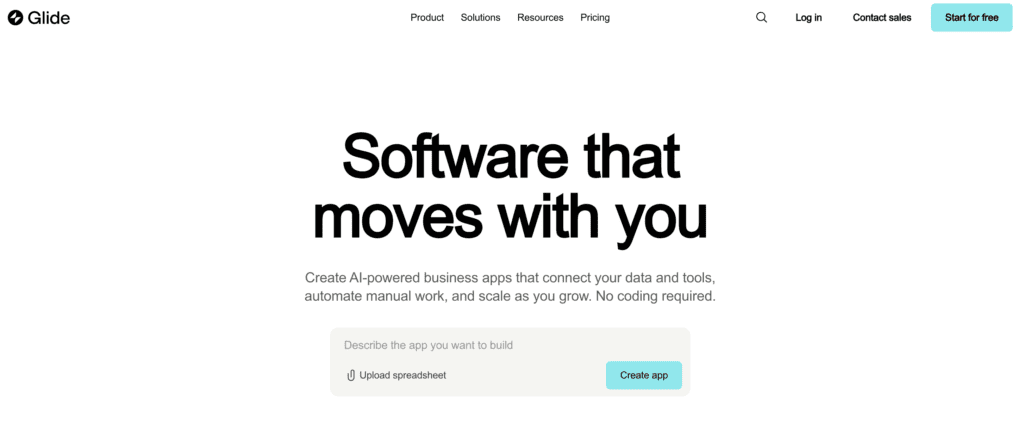
Glide translates plain-English prompts into spreadsheet-powered apps and internal tools quickly and intuitively. Its strong integration with data sources (Google Sheets, Airtable) makes data-driven app creation straightforward and accessible. Ideal for small to medium businesses needing quick internal app solutions.
- Key Advantages: Quick data-app creation; intuitive spreadsheet integration; no coding required.
- Target Audience: SMBs, non-technical teams, internal business users.
- Complexity: Low-to-medium, spreadsheet-driven internal apps.
- Pitfalls: Limited code export and customization; scalability is restricted by data sources.
6. Google Opal
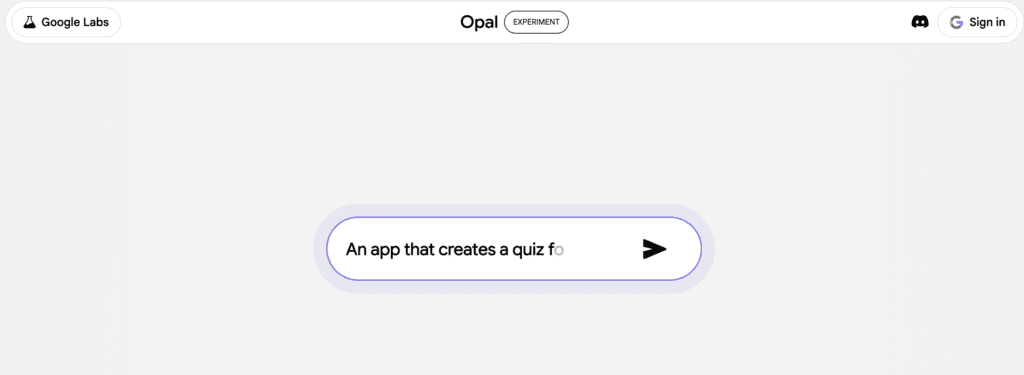
Google Opal is a conversational AI mini-app builder, combining a visual editor with prompt-based interactions, suitable for rapid prototyping of interactive mini-apps. Its recent global expansion positions it as an attractive platform for users looking for accessible, no-code AI app solutions with Google’s ecosystem.
- Key Advantages: Visual workflow editor; Google ecosystem integration; easy conversational design.
- Target Audience: SMBs, non-technical users, hobbyists, marketers.
- Complexity: Low-to-medium, mini-apps, conversational interactions, small internal utilities.
- Pitfalls: Early-stage product maturity; limited enterprise-level security controls.
7. Lovable
Lovable offers a fast and approachable way to create full-stack web apps using natural-language prompts, making it ideal for solo founders, early-stage startups, and marketers looking to demo ideas quickly. It emphasizes ease-of-use, rapid iteration, and built-in AI features.
- Key Advantages: Easy full-stack demo generation; integrated AI tools; user-friendly UX.
- Target Audience: Solo founders, marketers, and early-stage startups.
- Complexity: Medium, simple full-stack MVPs, demo apps.
- Pitfalls: Code quality concerns for production use; potential lock-in without clear code export.
8. OpenAI Apps (Apps SDK inside ChatGPT)
OpenAI Apps brings app-building directly into the ChatGPT environment, allowing developers to create conversational, chat-native apps and integrations. With native access to ChatGPT’s extensive user base, it provides an intriguing distribution channel for conversational products and integrations.
- Key Advantages: Built-in distribution; tight integration with ChatGPT ecosystem; conversational UX.
- Target Audience: Developers targeting conversational apps, ChatGPT plugin creators, innovators.
- Complexity: Medium, conversational apps, integrations, chatbot extensions.
- Pitfalls: Dependent on OpenAI policies; uncertain monetization strategy; limited EU availability.
9. Retool (AI-Generated Apps)
Retool leverages structured components and deterministic code generation to transform natural-language prompts into internal apps reliably. With a strong enterprise focus, Retool offers advanced data integration capabilities, governance, and auditability.
- Key Advantages: Strong enterprise-grade integrations; deterministic outputs; high maintainability.
- Target Audience: Enterprise teams, technical product managers, internal tooling teams.
- Complexity: Medium-to-high, complex internal tools, admin dashboards, operations apps.
- Pitfalls: Higher initial complexity; still evolving AI features, requiring hands-on refinement.
10. Replit Agent
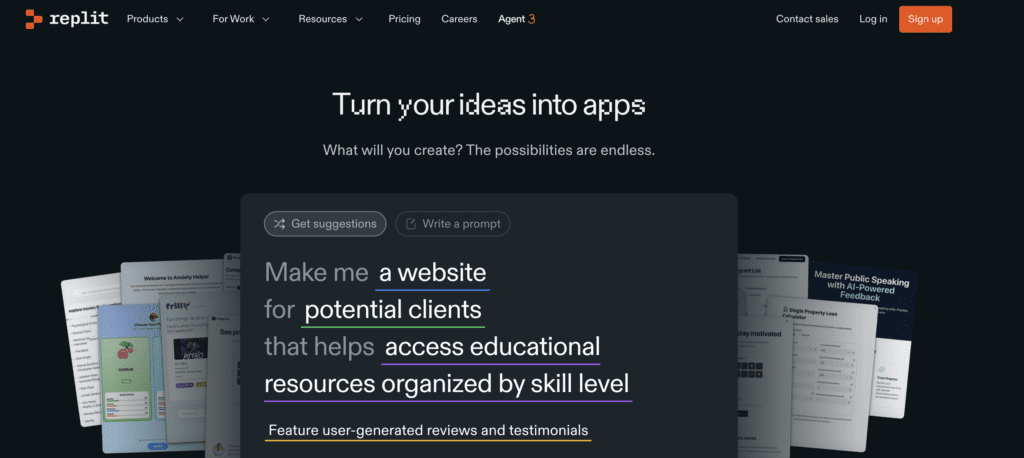
Replit Agent offers a conversational cloud-based IDE enabling end-to-end app creation and deployment from natural-language prompts. Ideal for developers wanting a frictionless experience from prototype to deployment, Replit emphasizes speed, ease of iteration, and built-in collaborative workflows.
- Key Advantages: End-to-end prompt-to-deploy workflow; cloud IDE integration; rapid prototyping and collaboration.
- Target Audience: Developers, innovation teams, educators, and students.
- Complexity: Medium, small-to-medium-sized web apps, collaborative projects, educational use cases.
- Pitfalls: Past autonomous-agent incidents; requires strict controls, audit trails, and governance before production use.
11. ToolJet (AI-Powered)
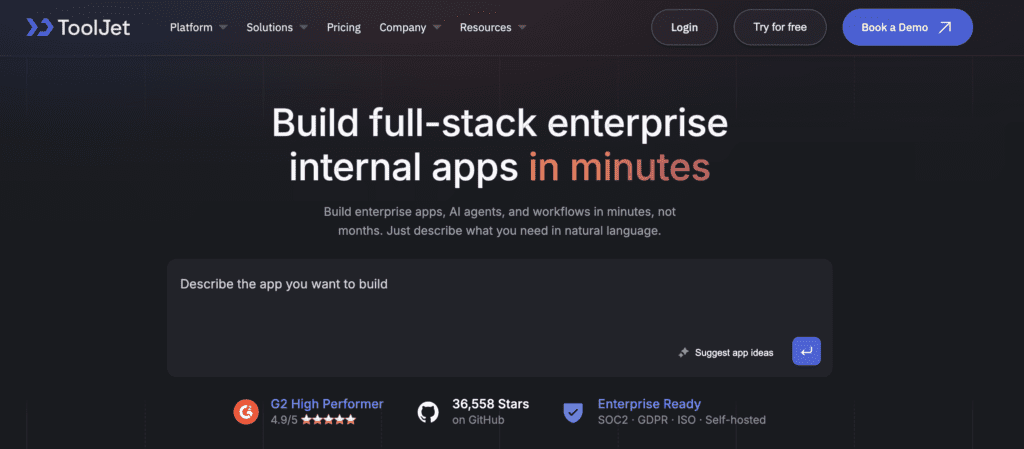
ToolJet enables users to convert conversational descriptions into internal applications using open-source infrastructure. It provides flexible integration with databases, APIs, and third-party services, making it attractive for teams needing custom-built internal tooling.
- Key Advantages: Open-source flexibility; extensive integration capabilities; strong customizability.
- Target Audience: Tech-savvy internal tooling teams, open-source enthusiasts.
- Complexity: Medium, internal tooling, integrations, and CRUD apps.
- Pitfalls: Moderate learning curve; requires technical proficiency for advanced scenarios.
12. Zoho Creator (Co-Creator)
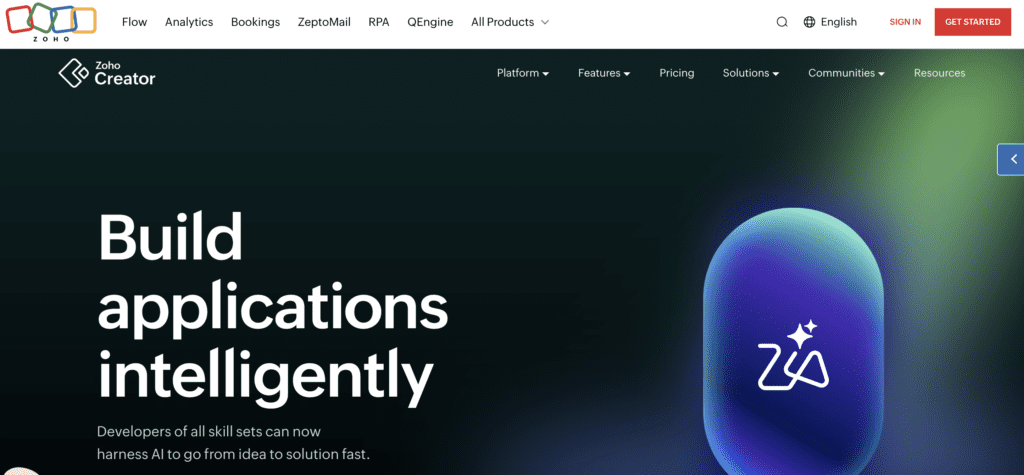
Zoho Creator’s Co-Creator allows business users to quickly generate apps through natural-language prompts, seamlessly extending Zoho’s established low-code environment. This makes it perfect for businesses already invested in Zoho’s ecosystem, looking for streamlined, AI-assisted app creation.
- Key Advantages: Robust low-code + AI-assisted environment; extensive Zoho ecosystem integration; strong SMB appeal.
- Target Audience: Existing Zoho users, SMBs, and non-technical business users.
- Complexity: Medium, business process automation, forms, CRM apps.
- Pitfalls: Ecosystem dependency; potential for vendor lock-in; limited flexibility outside Zoho’s offerings.
Conclusion
Prompt-to-app builders are no longer a novelty; they’ve become essential tools in modern software development, helping teams rapidly transform ideas into functional, scalable applications. The top 12 platforms covered here demonstrate diverse strengths, from rapid prototyping and ease of use to deterministic code generation and enterprise-grade controls. In 2025, choosing the right tool means balancing conversational ease, structured outputs, security, and flexibility to ensure long-term maintainability.
If you want prompt-driven speed without sacrificing professional code quality, full code ownership, and maintainable structure, give Flatlogic Generator a try. It turns your simple prompts into fully exportable, version-controlled applications built for real-world business demands, no vendor lock-in, no hidden risks.